Container planting is an essential part of a full, vibrant landscape. Adding containers (typically filled with colourful annuals and perennials) to your entryway, patio, or garden is very trendy nowadays – and rightfully so! Adding containers helps create custom focal points and add texture and colour to your landscape, but it can also be overwhelming.
So, where should you start?

The Basics of Container Planting
The practice of container planting may seem daunting at first. There’s a long list of questions that you should ask yourself before you dive in:
- Which type/size of container should I select?
- How do I choose which plants to put in?
- How many plants should I get?
- Where should I put the container?
- How often should I water the plants?
The list of important questions to ask yourself before getting started sometimes seems endless, and many people tend to give up before they start. The truth, however, is that container planting is pretty easy if you’re willing to get your hands a little dirty, and the opportunities for creativity are virtually endless.
Here are some basic tips for creating nice containers in your landscape.
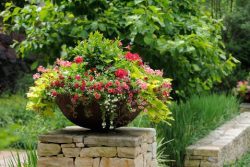
Choosing a Container
Like many things in life, it’s important to consider form and function when choosing the right planter.
In terms of function, it’s important to get yourself a container that’s the right size to meet your goals. First, consider where you’re going to be putting the planter and ensure that it’s the right size to fit there. Consider also which plants (and how many) you’d like to add. You should also check to make sure it has drainage holes and won’t be too difficult for you to move – especially if you’re working by yourself.
In terms of form, always think about how the planter you’re choosing will fit in with your landscape. Some planters are simple, trendy, and modern, whereas other planters are ornate and formal. Identify whether your landscape is informally or formally designed, and try to choose a planter to match.
What are Planters Typically Made of?
Wood
Wood planters are attractive, classic, and readily available. They can be custom-made to fit into different areas, and they’re perfect for striking a balance between your organic plant life and rigid, unmoving hardscapes. However, unprotected wood can deteriorate quickly when wet, so it’s important to line the interior of the planter with plastic sheeting before soil and drainage goes in.
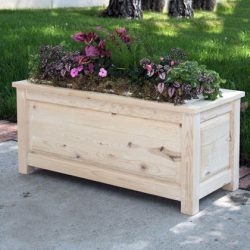
Glazed Ceramic
Ceramic planters are strong but porous, meaning they’re durable while allowing oxygen to easily get to the roots of the plants. They’re resistant to cold temperatures, add a formal look to your landscape, and come in a variety of colours. However, they can also be very heavy and brittle, and therefore easily damaged in transit.

Concrete
Concrete planters are very heavy, but they’re also durable year round, providing good insulation for sensitive root structures. They can be made to look ornate and fancy, or kept simple. They’re expensive, but because they’re so durable, it’s unlikely you’ll ever have to replace them.

Poly Resin
A more-recent innovation, poly-resin planters are extremely lightweight and durable. They’re very easy to move and rarely crack or fade, but plants with dense or thick root structures (like bamboo) can be extremely difficult to remove later without breaking the planter, so choose your plants wisely!

Though these are the most common containers available, there are many other types of planters you can get, including copper, aluminum, terra cotta, and more. Some people like to get creative with their planters, using atypical household objects. It all depends on what you like – feel free to get creative, but remember that whatever you choose should seamlessly match the rest of your landscape!
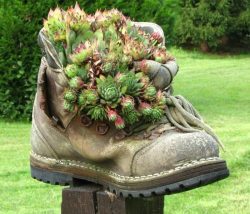

Putting the Planter Together
Step 1: Drainage
Remember – excess water in your planter has to go somewhere. If it sits in the pot without draining, it will eventually produce mold and/or drown your plants! Therefore, no matter which type of planter you’re thinking of getting, always check to make sure it has proper drainage holes in the bottom. If you choose to purchase a planter without drainage, you should use a drill to add your own.
 The next step is to add filter fabric and drain material. You should use the filter fabric to cover the drainage holes to prevent clogging. Then, use a free-draining void material such as drain rock, river rock, packing peanuts, or Styrofoam to infill at least four inches at the bottom of your planter (depending on its size). Place one more layer of filter fabric over the top of your drain material to prevent your topsoil from mixing in.
The next step is to add filter fabric and drain material. You should use the filter fabric to cover the drainage holes to prevent clogging. Then, use a free-draining void material such as drain rock, river rock, packing peanuts, or Styrofoam to infill at least four inches at the bottom of your planter (depending on its size). Place one more layer of filter fabric over the top of your drain material to prevent your topsoil from mixing in.
Step 2: Potting Mix
This step is simple! Simply fill the remainder of your planter with proper potting mix, which is lighter than regular soil and won’t compact as much over time, allowing for adequate air circulation for your plants.
Step 3: Plants
This is the fun part of container planting! Selecting plants and arranging them within your planter is where you really get to be creative and artistic. Ultimately, it’s your planter – therefore, you can do whatever you want, however you want. However, there are a few basic guiding principles we like to follow that will allow for maximum textural interest and colour variety within your container.
When it comes to container planting, there are three types of plants we like to use in tandem: thrillers, fillers, and spillers.
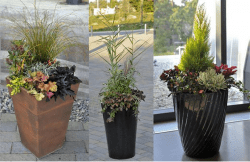
Thrillers
A thriller is a large, bold plant with a pronounced shape. Often, it’s the first plant you notice. In smaller planters, there’s usually only one thriller plant.
Examples:
- New Zealand Flax (phormium tenax)
- Heavenly Bamboo (nandina domestica)
- Yucca (yucca filamentosa)
- Lemon Cypress (cupressus macrocarpa ‘Goldcrest’)
- Ornamental grasses
- Canes
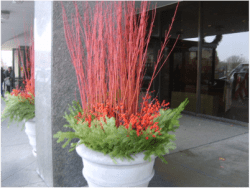
Fillers
A filler is a smaller, mounding plant or annual that you place around the thriller. They add unique shapes and colours to the container.
Examples:
- Coral Bells (heuchera)
- Skimmia (skimmia japonica)
- Euphorbia (euphorbia sp.)
- Annuals (pansy, primula, etc)
- Dusty Miller (jacobaea maritima)
- Blue Star Juniper (juniperas squamata ‘Blue Star’)
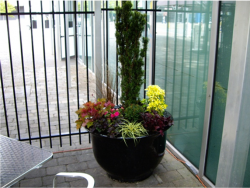
Spillers
A spiller is a plant of groundcover that cascades over the edges of the pot, adding a colourful skirt that helps accentuate the shapes of the other plants.
Examples:
- Carex (carex oshimensis)
- Ivy (hedera helix)
- Potato Vine (ipomea)
- Trailing Sedum (sedum morganianum)
- Creeping Jenny (lysimachia nummularia)
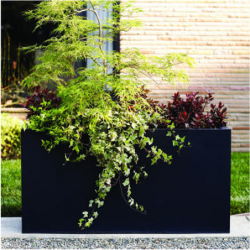
Container Planting – General Tips
- If your container is heavy by itself, imagine how heavy it will be when it’s full! Get your planter in position before you fill it up.
- Consider plant sizes and proportions. A gigantic planter stuffed with short plants will look strange and out of place. Try to have at least one plant that is roughly the same height as the container.
- Use appropriate plants. If your planter is in the shade, use shade-tolerant annuals and perennials. If it’s in the sun, use drought-tolerant of full-sun plants. If you choose the right plants for the right place, you’ll save time on maintenance.
- Maintenance is key! Don’t be afraid to prune plants once they grow ragged. You should also remove weeds as they arrive, and don’t over or under-water your plants.
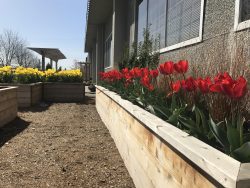
Our Plant-Up Program Annuals Displays
Twice yearly at Para Space, we update our annuals displays and containers at all of our maintenance properties. It’s a month-long effort requiring a great deal of planning and literally thousands of new plants, but we believe it’s important to add pops of colour to high-profile areas of our landscapes, and we’re always proud of our end results!
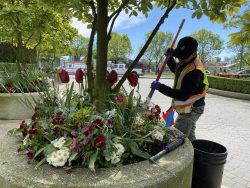
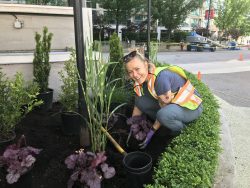
If you could use some help with your container planting displays, consider getting in touch! We’d love to help you spruce up your apartment building, condo, home, or business with some textural or colour interest.


Comments are closed here.